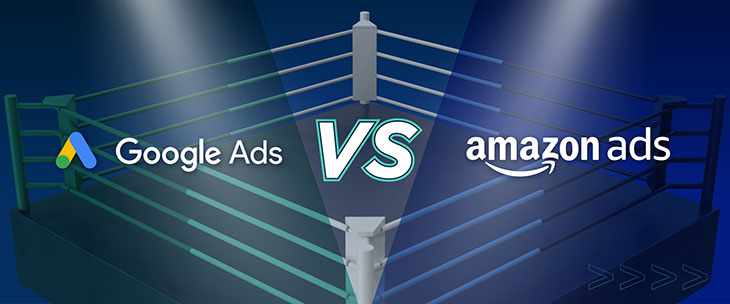As a brand owner, never underestimate the importance of pay per click (PPC) advertising. If you’re unfamiliar with the term, PPC is an advertising strategy employed to drive traffic to a specific page on a website. An advertiser pays a publisher every time an ad is clicked, so it pays to know the best source for PPC. Logical Position has worked with both Google and Amazon and their individual PPC solutions. So, Amazon PPC vs. Google PPC: What’s the difference? Here are the pros and cons of each publisher’s system and style, and how you can get the most bang for your advertising buck.
A Whole New World
For the past two years, online shopping has boomed. PPC advertising has become much more crucial to get your products in front of potential customers, and it only continues to rise in importance. During the pandemic, consumers shifted their purchasing patterns because buying online was easier than buying locally and in-person. Sellers likewise flocked to Amazon, seeing greater opportunity to sell goods there, due to the ease of shopping and fast shipping. Sellers saw additional opportunities for driving sales through Google PPC as well. However, more sellers meant increased competition. The biggest battle was for a position on the top page and first row of search results. For that, PPC became the best tool to influence search results and put products in front of customers’ eyes. The question is: Which is better for your purposes? It’s a complex question, but here’s a breakdown of the benefits and drawbacks of advertising on Google vs. Amazon.
The Ins, Outs, Ups, and Downs of Amazon
As mentioned above, Amazon is an excellent platform for reaching customers with an intent to purchase. With more and more people adopting Amazon as a marketplace where they can routinely purchase the products they need, it provides an increasing opportunity to grow sales. But it has its cons as well. For instance, Amazon charges a fee to sell on the platform, and it also takes a percentage from every product sale. Sellers who enjoy the most success on Amazon often have a direct relationship with their brand, whether they own the brand outright or buy wholesale as an approved reseller. Moreover, when a seller depends on Amazon to handle their products, they need to send those products to Amazon’s warehouses to fulfill orders. That comes with, you guessed it, another fee. All those fees add up, and they can eat away at profits. A seller ends up paying for Amazon’s infrastructure and convenience along the way, but ultimately, they need to figure out how the costs of selling on Amazon, and the added cost of PPC, can work for them.
Google, Amazon, and Algorithms
We don’t know the specifics of Amazon’s algorithm or how exactly it works. It’s all very hush-hush, which is understandable as a piece of proprietary software. However, we do know there are key differences in terms of how Amazon promotes products on a paid basis versus Google. Google seeks to serve ads or advertise products that drive clicks, because that’s how they generate revenue. Amazon, on the other hand, creates revenue according to what sells. With them it’s not strictly about promoting the products that generate the most clicks or the highest click-through rates. Most often, it’s the products most likely to complete the sale.
Amazon boosts the organic rankings of products based on two primary factors: sales volume and sales velocity. Specifically, products with a long history of larger sales volume, a large number of reviews, and successful sales track record have a better chance of organically ranking higher on Amazon. On Amazon, a non-sponsored listing can appear below the first row and outside the sponsored spots in this way. Google, conversely, is adamant about organic rankings remaining independent of ads. Instead, rankings are directly related and dependent on a website’s search engine optimization. Breaking it down, advertising on Amazon is terrific at helping to increase sales velocity, which in turn positively influences organic rankings and can lead to even more sales growth. On the other hand, and according to Google, spending on Google Ads doesn’t affect organic rankings. That means they retain their relevance through search terms and keywords.
Tracking and Telling
One big difference between Google and Amazon PPC comes down to demographic targeting and the ability to target certain subsets of users. For now, Amazon Advertising doesn’t enable advertisers to target specific demographics (i.e. income, age, gender, geographic location), or even set an advertising schedule based on time of day or what device a customer is using. Google Ads, on the other hand, allows advertisers to adjust bids or stop an ad from being served based on any of these factors. As such, Google gives sellers more opportunity to serve their ads to a specific audience or type of user, based on what they know about their ideal customer. This can save you money by limiting wasted clicks. On the flip side, Amazon shows results for searches based on the advertiser with the highest bid, as well as what products are most relevant or have sold for similar searches in the past. On Google, instead of the actual sale driving the ranking or placement of an ad, the ad content or click volume drives it.
Hitting the Target
Another big difference between Google and Amazon is the bidding process for product listing ads. Google Shopping campaigns let the advertiser set a bid for a specific product and then relies on Google to match product variations with relevant customer searches. However, bidding on specific search terms isn’t possible for Shopping, nor can you pick specific keywords to double down on. Conversely, Amazon allows advertisers to target a specific list of relevant keywords for their products. The advertiser can take 5 to 10 of their highest-value keywords, build them out using desired match types, and give them specific bids. As an example, you can target the term kids sneakers, then target the longer-tail keyword red kids sneakers size 5 and attach a different product to each keyword depending on what product is more relevant on a shopping basis. The ability to target specific terms in a marketplace inherently built for buying is more concrete than a text or product listing ad on Google, where search terms will have more variability.
The Minuses
Of course, every system has its flaws. As previously stated, Amazon isn’t the place for every seller. Good margins are key to retaining profitability on Amazon. Even if a seller drives high volume, if their margins are too slim they won’t get the return they need to cover expenses and Amazon’s fees. Compared with Google Ads, Amazon’s advertising system is also a relative newcomer, having only been in use for the past five years. It still has a few bugs to work out, too. Reporting options are limited, and the system doesn’t provide a keyword or individual Shopping product tab like Google does. Search Term Reports can only be pulled for the last rolling 60 days, and Amazon limits product spend reports to a 90-day quick view.
On the other hand, Amazon gains an advantage over Google when it comes to conversion rates. Since Google is primarily a search engine, a decent percentage of users who search on the platform are doing so for research purposes only. They may click on an ad, but on average they are less likely to make a purchase than customers on Amazon. Amazon, alternatively, is a marketplace built for people to buy. Average conversion rates are double on Amazon versus Google, and there is additional opportunity to scale one’s business if you invest in PPC advertising. Since organic rankings (and therefore organic sales) are directly related to sales volume, you can effectively influence growth by driving sales through ads.
Conclusions
We’ve considered the question Amazon PPC vs. Google PPC: what’s the difference? from several angles. Obviously, no PPC system is perfect for everyone, but each has its pros and cons. In general, Amazon is its own beast with challenges to overcome, especially when it comes to added fees. It’s higher risk because of the higher costs involved, but it can also reap higher rewards and more volume as well, even for smaller sellers. If a company can afford the percentage that Amazon eats into its margins, it has the potential to scale volume in ways other platforms cannot match. Google, on the other hand, lets you reach specific consumers without paying additional fees. You take home more of each sale, which can really add up.
If you want to explore Amazon advertising management and other Google and Amazon advertising solutions offered by Logical Position, contact us today!




